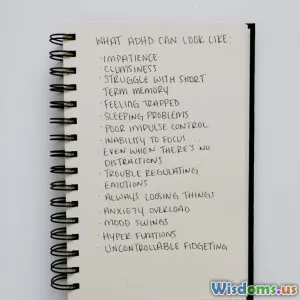
Creating a Vision Board for Your Future
8 min read Unlock your potential by creating a vision board that vividly maps out your future goals and dreams. (0 Reviews)
Creating a Vision Board for Your Future: A Guide to Manifesting Your Dreams
Introduction
Have you ever wondered why some people seem to transform their dreams into reality while others struggle to find direction? One compelling answer lies in the power of visualization, and more concretely, the practice of creating a vision board. A vision board is not just a collage of pretty images—it's a psychological tool that helps you set clear intentions, prioritize your goals, and maintain motivation. In this article, we explore how creating a vision board can be a transformative personal development strategy, backed by psychological insights and practical tips, encouraging you to shape your future with clarity and purpose.
The Psychological Power of Visualization
Visualization is a well-studied psychological technique used in fields as diverse as sports psychology, therapy, and goal achievement. According to Dr. Shelley Carson, a Harvard psychologist, visualizing the process of achieving a goal increases confidence and primes the brain for success by activating neural pathways related to the action.
A vision board leverages this principle by providing a tangible, visual representation of your goals. The act of curating images and affirmations helps to externalize your dreams, making them feel more concrete. Studies have indicated that people who clearly define and visualize their goals are significantly more likely to accomplish them — in some cases by up to 42%, according to a 2015 Dominican University study led by Dr. Gail Matthews.
Moreover, frequently seeing your vision board helps embed your intentions into your subconscious, influencing your daily decisions and actions, often without you realizing it.
Step-by-Step Guide to Creating Your Vision Board
1. Clarify Your Goals and Dreams
Before gathering images, spend time reflecting on what you genuinely want in various areas of your life: career, health, relationships, finances, personal growth, and leisure. Be specific, as vagueness can dilute your focus. Journaling or mind mapping can help organize your thoughts.
_For example, instead of "I want to get fit," try "I want to be able to run a 5K by September." _
2. Collect Visuals & Materials
You can use magazines, printed images from the internet, photographs, or even handwritten affirmations. Online tools like Pinterest also allow you to create digital vision boards. For a tactile, immersive experience, physical boards often stimulate engagement more deeply.
3. Create the Board with Intention
Arrange your images and words thoughtfully—group similar themes together or place your highest priorities in the most visible spots. Use colors and quotes that inspire.
Case study: Oprah Winfrey is known for creating multiple vision boards annually, famously crediting them with attracting specific life milestones.
4. Display Your Vision Board Prominently
Place your vision board where you'll see it daily. Consistent exposure helps reinforce your mindset and reminds you of your stratagem towards your future.
5. Review and Update Regularly
Life evolves, and so can your goals. Reviewing and updating your vision board every few months keeps it relevant and re-energizes your commitment.
Real-World Impact: Stories of Success
Example 1: Jim Carrey's Manifestation Story
Before fame, actor Jim Carrey wrote himself a $10 million check for "acting services rendered" and dated it Thanksgiving 1995. He kept it in his wallet and visualized his success daily. Within a few years, his acting career skyrocketed, and he received a $10 million paycheck for "Dumb and Dumber," manifesting his vision with compelling clarity.
Example 2: Richard Montañez and Frito-Lay
Richard Montañez, starting as a janitor, envisioned creating a snack for the Hispanic market and presented the idea of Flamin' Hot Cheetos to executives, eventually leading to a billion-dollar product and his rise to executive leadership—a testament to goal-setting and visualizing success.
These stories embody how clear vision and visualization are powerful forces for personal development.
Psychological Tips to Enhance the Effectiveness
-
Incorporate Positive Affirmations: Words shape belief. Including affirmations like "I am confident and capable" helps boost self-efficacy.
-
Engage Multiple Senses: Whenever possible, attach objects or elements beyond pictures to make your board multi-sensory.
-
Leverage Emotional Connection: Choose images and goals that genuinely excite and inspire you—engagement fuels persistence.
-
Practice Mindfulness with Your Vision Board: Spend a few minutes daily visualizing each goal as if achieved, allowing you to experience the emotions related to success, reinforcing your motivation.
Common Pitfalls and How to Avoid Them
-
Setting Unrealistic Goals: While it’s powerful to aim high, goals should be achievable. Balance ambition with practical steps.
-
Lack of Specificity: Vague goals dilute focus. Clear, measurable objectives improve progress tracking.
-
Treating Vision Boards as Magic: It’s a tool—not a guarantee. Consistent action aligned with your vision is what drives real results.
-
Neglecting Emotional Authenticity: Including goals that do not resonate emotionally can render the board ineffective.
Conclusion
Creating a vision board is a creative and engaging way to clarify your aspirations and ignite inner motivation. By harnessing psychological principles of visualization and goal-setting, you give yourself a roadmap—not just in words but in vibrant images—to direct your focus and fuel action toward your dreams. Remember, the power of a vision board lies not simply in seeing but believing in your future self and working steadily toward making that vision a reality. Whether you aim to grow your career, enrich relationships, or boost wellness, your vision board becomes a daily reminder that your future is within your crafting.
Enable your imagination, commit boldly, and witness how visualizing your future can start turning dreams into achieved milestones.
Rate the Post
User Reviews
Popular Posts





















